Disrupting the Space-Time Continuum: Competency-based Learning Explained

This post first appeared on Teaching and Learning Blog, November 6, 2013.
The long-held notion that learning can be confined to a space-time continuum with “seat” as the space, and “credit hour” as the variable for time is rapidly declining in its appeal. A shift to 21st-century-relevant and sector-specific learning credentials not only nods to a more qualified future workforce (read; a stronger economy), but also to a better chance of gainful employment for those who choose to embark on the journey of higher education…and while we’re at it, to less student debt along the way. In short, competency-based learning allows more students to obtain the real skills they need, in less time, and with what would seem to be greater chance for success. Competency-based learning allows students to circumvent the accumulation of excessive and often-wasted credits simply for the sake of fulfilling (what many believe to be) an arbitrarily defined term of study along the aforementioned continuum.
I hope you’ll continue on in this multi-part blog journey with me as Pearson’s Curriculum Consultant Brent Capriotti answers some of the most commonly asked questions about competency-based learning. If you have a question that isn’t represented here, feel free to send it to me in the Comments box below. No question is too basic, so don’t be shy. #AlwaysLearning,#AlwaysListening. Now, over to Brent to learn how competency-based learning benefits the person who matters most—the student.
-Gillian Seely
Editor, Teaching & Learning Blog
GS: Hi Brent. Can you give our curious readers a basic, boiled-down definition of competency-based learning?
BC: Hi, Gillian! Here’s the best definition we have at this point:
“Competency-based learning is a model of education that uses learning, not time, as the metric of student success. Focusing on competencies derived from the skills proven to be most relevant by educators and employers, students acquire competencies (often in an online, self-paced environment), and may also earn credit for prior learning, thus accelerating their progress toward a credential. In short, competency-based learning approaches are more student-centered: meeting students where they are and focusing on the learning they need.”
GS: What a great definition! Now let’s talk about the student. Broadly, how does competency-based learning benefit the individual learner?
BC: Well, part of the reason we’re so excited about this shift is that the student is really at the center of the entire competency-based learning model, and that holds true in a number of ways around access, time-to-completion, flexibility, affordability, focus on employability, personalized learning paths for instruction/remediation, and more.
GS: Can you explain how competency-based learning helps students save time?
BC: In competency-based environments, students are rewarded for prior learning, and not asked to start from scratch in every area of their learning experience. This happens by way of personalized learning paths or even “testing out” of specific topics/modules/courses. This prior learning need not be qualified and documented via previous coursework or classes; it’s competency-based and demonstrated via prior learning assessments, or PLAs. Some examples of institutions that are doing this well can be found in this briefing paper on competency-based learning. Also, as you pointed out earlier, with a focus on the accumulation of competencies as the measure of success, students can avoid having to take unnecessary course content to meet time requirements. And then there’s the possibility for reduced time-to-employment by compressing a degree or certificate program. There’s a lot to be said for being able to apply for a job and know that you can confidently say to a potential employer, “I have all the skills you want, they are relevant, and I am exactly the person you want in this position…and here’s the certification to prove it.”
GS: That leads me to the idea of flexibility in competency-based programs. Is this model something that brings greater flexibility to the student? If so, how?
BC: Competency-based programs are associated with online, asynchronous, student-driven (non-cohort) approaches in which students learn at their own pace and on their own schedule. This does not mean that all such programs must have these qualities, but it’s becoming a common assumption. I think it’s important to note that this won’t always be the case, but in those instances where competency-based learning is happening in an online, asynchronous environment, yes– certainly students will be able to take advantage of self-paced learning, which can lead to incredible flexibility. I want to be clear that competency-based programs can (and should) be just as rigorous as their more traditional counterparts are perceived to be, and in some cases, more so. This is not simply a means for students to get an education quickly.
GS: On that note, let’s talk about achievement within a competency-based framework. How rigorous can these courses be, and what exactly is the end-goal for a student in a competency-based program?
BC: In a rigorous, well-designed competency-based program, (remember that learning design is so important in any program, whether competency-based or not), students are asked to demonstrate a truly authentic grasp of essential learning outcomes. In many cases, this kind of learning can prove more challenging than that taking place in a program based on less rigorous/authentic measures of success. In essence, this model makes it very difficult to glaze over a skill or topic. The practical result of that is a graduate who has documentation pointing to their areas and levels of proficiency, and that documentation serves as evidence of their workforce readiness. This gives that student a competitive edge over a more traditionally educated counterpart. For example, Northern Arizona University’s competency-based program provides graduates with diplomas, traditional transcripts, and a “competency report”.
Pearson is a Getting Smart Advocacy Partner.






0 Comments
Leave a Comment
Your email address will not be published. All fields are required.